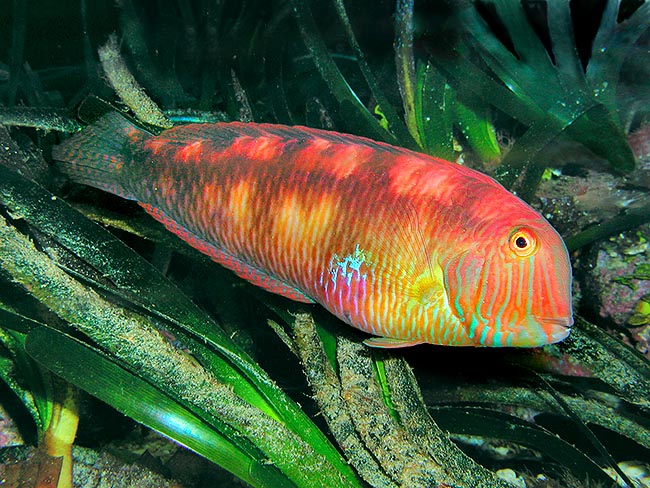Family : Labridae

Text © Giuseppe Mazza

English translation by Mario Beltramini
The Pearly razorfish (Xyrichtys novacula Linnaeus, 1758) belongs to the class of Actinopterygii, the ray finned fishes, to vast order of Perciformes and to the family of Labridae.
The name of the genus comes from the Greek “xyreoé” = to shave, to cut and “icthys” = fish. The name of the species comes from the Latin “novacŭla”, meaning razor.
Concluding, as the Genoese say in their dialect, it is also a “Pescio razù”, that is a razorfish. This, obviously, due to its flat structure which allows it to disappear n a jiffy under the sand, for escaping the predators, for sleeping or for spending the winter.
Zoogeography
Present in all the Mediterranean, but the Black Sea, it is found on the two sides of the Atlantic, with a liking for the Caribbean and, usually, the warm waters.
Ecology-Habitat
Apart the coral reefs, more than the rocks, it loves the sandy, clean, low bottoms and the seagrass meadows. We usually find it between the 5-10 m of depth, even if, in order to shelter from the winter cold, it may go down up to 90 m.

Cleaver wrasse or Pearly razorfish (Xyrichtys novacula) feels the cold and changes sex © Giuseppe Mazza
Morpho-physiology
It measures 15-20 cm, but the males, bigger, may exceptionally reach the 30 cm. Apart the thickness, it can be recognized at once thanks to its showy livery and the profile of the head, almost vertical.
The eye is small, very high in respect to the mouth, horizontal and tiny, but well equipped of teeth. The central ones, bigger, are protruding and are sharp as canines, but there are also, more deeply, some molars and, finally, we can see some flat teeth on the pharynx.
There is only one long dorsal fin, starting immediately after the head, and an anal one, similar but shorter. The pectoral ones are relatively wide and the ventral small. As is the case for the Coris julis and many wrasses, it is a protogynous hermaphroditic species. The females, when ageing, become males. The background tint is pink or red, with blue bands and arabesques, more or less intense.
Ethology-Reproductive Biology
It mainly nourishes of molluscs and crustaceans, but also of echinoderms, cnidaria, bryozoans and foraminiferans.
In the Mediterranean, the reproduction takes place in summer, with floating eggs with a very rapid development. The post-larval stages are little known, but it seems that the young spend all the winter under the sand. The vulnerability index of this species is of 36 over 100.
Synonyms
Amorphocephalus granulatus Bowdich, 1825; Coryphaena lineata Gmelin, 1789, Coryphaena lineolata Rafinesque, 1810; Coryphaena novacula Linnaeus, 1758; Coryphaena psittacus Linnaeus, 1766; Hemipteronotus copei Fowler, 1900; Hemipteronotus novacula Linnaeus, 1758; Hemipteronotus psittacus Linnaeus, 1766; Novacula coryphaena Risso, 1827; Novacula coryphaenoides Schinz, 1822; Novacula coryphena Risso, 1827; Novacula cultrata Valenciennes, 1840; Novacula lineata Gmelin, 1789; Novacula lineolata Rafinesque, 1810; Novacula novacula Linnaeus, 1758; Xyrichthys argentimaculata Steindachner, 1861; Xyrichthys binghami Mowbray, 1925; Xyrichthys cultratus Valenciennes, 1840; Xyrichthys jessiae Jordan, 1888; Xyrichthys psittacus Linnaeus, 1766; Xyrichthys rosipes Jordan & Gilbert, 1884; Xyrichthys uniocellatus Agassiz, 1931; Xyrichthys vermiculatus Poey, 1860; Xyrichthys vitta Valenciennes, 1840.
→ For general information about FISH please click here.
→ For general information about BONY FISH please click here
→ For general information about CARTILAGINOUS FISH please click here.
→ To appreciate the BIODIVERSITY of BONY FISH please click here.
→ To appreciate the BIODIVERSITY of CARTILAGINOUS FISH please click here.
